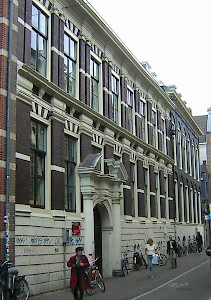Cornelis de Bruijn
Cornelis de Bruijn (c.1652-1727) was a Dutch artist and traveler. He is best known for his drawings of the ruins of Persepolis, the first reliable pictures of these palaces to be accessible for western scholars. His other visits included the Ottoman Empire, Egypt, Jerusalem, Russia, and the East Indies.
The return

Because in the eighteenth century, longitude was still impossible to measure, navigation was difficult, and when the sailors of De Bruijn's ship spotted land in September, it turned out to be southern Arabia. However, on 12 October, they reached Gamron. De Bruijn visited Shiraz again, saw the tomb of Cyrus the Great at Pasargadae (without realizing what it was), and returned to Isfahan, where he celebrated Christmas and New Year. On the first of March 1707, he continued to the north.
During the early summer, he crossed the Caspian Sea, reached Astrakhan, and moved upstream along the Volga to Saratov - suffering from shipwreck once. Over land, he continued to Vladimir, and arrived in Moscow, where he met Czar Peter again. Winter prevented De Bruijn from continuing his voyage, but on 10 February 1708, he left Moscow, taking the land route to Smolensk.

This turned out to be a mistake. The Great Northern Warnote was still continuing and De Bruijn traveled straight into the vortex. The Swedish king Charles XII had already defeated the Danish and Polish armies, and in 1708, he invaded Russia. The retreating Russian army, employing the tactic of the scorched earth, destroyed everything it could. De Bruijn and his four English fellow travelers saw an utterly desolated country, and were in constant fear of Russian cavalry on pillaging missions and Swedish cavalry that had to prevent the destruction of everything.

Still, the travelers reached Smolensk and Minsk (in Poland), but before they could reach Vilnius, a group of Russian horsemen, believing the westerners to be spies, arrested them. Fortunately, an English officer in Russian service saved their lives. De Bruijn's old acquaintance Alexander Menshikov suggested the travelers to return to Moscow.
In the summer, De Bruijn returned to Archangelsk, and a ship called Hoogepriester Aäron brought him back to Holland. From 9 to 23 October, he stayed in Amsterdam, where he could pick up the luggage he had sent forward from Batavia. It had been stored in the headquarters of the VOC, the Oostindisch Huis (the East India House), for more than a year. This was not the least of Witsen's favors. On the twenty-fourth, De Bruijn arrived in The Hague, where his friends welcomed him.